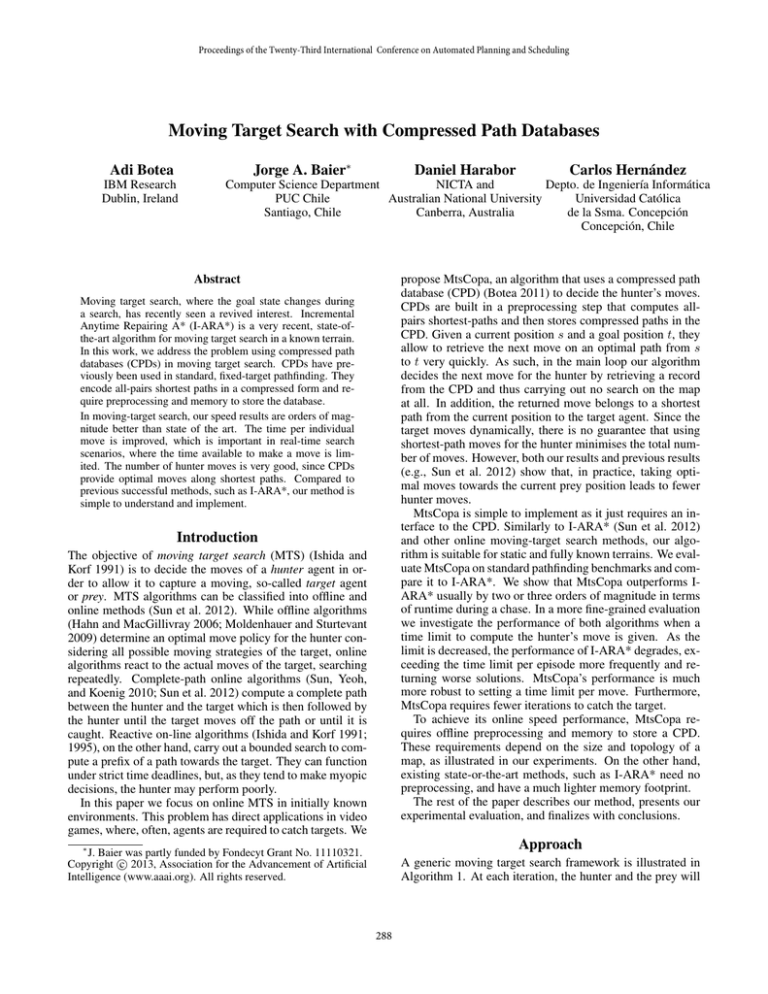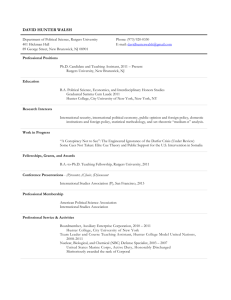
Proceedings of the Twenty-Third International Conference on Automated Planning and Scheduling
Moving Target Search with Compressed Path Databases
Jorge A. Baier∗
Adi Botea
IBM Research
Dublin, Ireland
Daniel Harabor
Carlos Hernández
Depto. de Ingenierı́a Informática
NICTA and
Computer Science Department
Universidad Católica
Australian National University
PUC Chile
de la Ssma. Concepción
Canberra, Australia
Santiago, Chile
Concepción, Chile
Abstract
propose MtsCopa, an algorithm that uses a compressed path
database (CPD) (Botea 2011) to decide the hunter’s moves.
CPDs are built in a preprocessing step that computes allpairs shortest-paths and then stores compressed paths in the
CPD. Given a current position s and a goal position t, they
allow to retrieve the next move on an optimal path from s
to t very quickly. As such, in the main loop our algorithm
decides the next move for the hunter by retrieving a record
from the CPD and thus carrying out no search on the map
at all. In addition, the returned move belongs to a shortest
path from the current position to the target agent. Since the
target moves dynamically, there is no guarantee that using
shortest-path moves for the hunter minimises the total number of moves. However, both our results and previous results
(e.g., Sun et al. 2012) show that, in practice, taking optimal moves towards the current prey position leads to fewer
hunter moves.
MtsCopa is simple to implement as it just requires an interface to the CPD. Similarly to I-ARA* (Sun et al. 2012)
and other online moving-target search methods, our algorithm is suitable for static and fully known terrains. We evaluate MtsCopa on standard pathfinding benchmarks and compare it to I-ARA*. We show that MtsCopa outperforms IARA* usually by two or three orders of magnitude in terms
of runtime during a chase. In a more fine-grained evaluation
we investigate the performance of both algorithms when a
time limit to compute the hunter’s move is given. As the
limit is decreased, the performance of I-ARA* degrades, exceeding the time limit per episode more frequently and returning worse solutions. MtsCopa’s performance is much
more robust to setting a time limit per move. Furthermore,
MtsCopa requires fewer iterations to catch the target.
To achieve its online speed performance, MtsCopa requires offline preprocessing and memory to store a CPD.
These requirements depend on the size and topology of a
map, as illustrated in our experiments. On the other hand,
existing state-or-the-art methods, such as I-ARA* need no
preprocessing, and have a much lighter memory footprint.
The rest of the paper describes our method, presents our
experimental evaluation, and finalizes with conclusions.
Moving target search, where the goal state changes during
a search, has recently seen a revived interest. Incremental
Anytime Repairing A* (I-ARA*) is a very recent, state-ofthe-art algorithm for moving target search in a known terrain.
In this work, we address the problem using compressed path
databases (CPDs) in moving target search. CPDs have previously been used in standard, fixed-target pathfinding. They
encode all-pairs shortest paths in a compressed form and require preprocessing and memory to store the database.
In moving-target search, our speed results are orders of magnitude better than state of the art. The time per individual
move is improved, which is important in real-time search
scenarios, where the time available to make a move is limited. The number of hunter moves is very good, since CPDs
provide optimal moves along shortest paths. Compared to
previous successful methods, such as I-ARA*, our method is
simple to understand and implement.
Introduction
The objective of moving target search (MTS) (Ishida and
Korf 1991) is to decide the moves of a hunter agent in order to allow it to capture a moving, so-called target agent
or prey. MTS algorithms can be classified into offline and
online methods (Sun et al. 2012). While offline algorithms
(Hahn and MacGillivray 2006; Moldenhauer and Sturtevant
2009) determine an optimal move policy for the hunter considering all possible moving strategies of the target, online
algorithms react to the actual moves of the target, searching
repeatedly. Complete-path online algorithms (Sun, Yeoh,
and Koenig 2010; Sun et al. 2012) compute a complete path
between the hunter and the target which is then followed by
the hunter until the target moves off the path or until it is
caught. Reactive on-line algorithms (Ishida and Korf 1991;
1995), on the other hand, carry out a bounded search to compute a prefix of a path towards the target. They can function
under strict time deadlines, but, as they tend to make myopic
decisions, the hunter may perform poorly.
In this paper we focus on online MTS in initially known
environments. This problem has direct applications in video
games, where, often, agents are required to catch targets. We
Approach
∗
J. Baier was partly funded by Fondecyt Grant No. 11110321.
c 2013, Association for the Advancement of Artificial
Copyright Intelligence (www.aaai.org). All rights reserved.
A generic moving target search framework is illustrated in
Algorithm 1. At each iteration, the hunter and the prey will
288
Map
take one action each. Once in a while, the prey’s action
is to wait, to ensure that the hunter eventually catches it.
Flag “captured” becomes true as soon as the hunter’s and
the prey’s locations are identical.
Nodes
161x161
169x169
193x193
676x676
130x130
512x512
10,691
19,440
19,662
311,040
10,280
92,268
1.8
3.6
3.6
203.0
2.0
27.0
Total
preproc.
minutes
0.8
2.8
2.8
1222.7
0.7
98.9
Domain Dragon Age: Origins (DAO)
orz100d
orz900d
Using Copa to implement a strategy for the hunter (or the
prey) is simple. Given a map, the program performs an offline preprocessing to compute a CPD. At runtime, a CPD
has the ability to answer fast first-move queries: given any
start–target pair, return a move from the start towards the
target along an optimal path. Such a property makes a CPD
particularly useful in problems such as moving target search,
where both the hunter’s and the prey’s position change dynamically. Our Copa-based implementation of the hunter,
which we call MtsCopa, queries the CPD for the start–target
pair (h, p), and uses the corresponding move.
395x412
656x1491
99,626
96,603
38.0
15.0
107.2
90.9
Domain Baldur’s Gate II (BG2)
AR0603SR
AR0300SR
AR0500SR
AR0700SR
512x512
320x320
320x320
320x320
32room 000
512x512
maze512-32-0
maze512-2-0
512x512
512x512
57,372
26,950
29,160
51,586
9.2
5.5
5.0
18.0
29.9
5.6
6.7
25.8
185.0
799.8
56.0
35.0
804.3
297.2
Domain Rooms
240,671
Domain Mazes
253,840
174,524
Domain Random (25% Obstacles)
Experimental Setup
rand512-25-0
rand512-25-1
We have compared our moving-target search solver, based
on Copa (Botea 2012), with the recent, state-of-the-art program I-ARA* (Sun et al. 2012). The source code of Copa
and I-ARA* were obtained from their respective authors.
In our experiments we used 17 grid maps sourced from a
variety of domains: computer game maps, maze maps, maps
with random obstacles and synthetic maps partitioned into
rooms with entrances. All are taken from Sturtevant’s online
repository1 (Sturtevant 2012). Following the approach of
Sun et al. (2012), all maps are considered to be 4-connected.
Table 1 provides details on the size of each map and includes additional statistics from our preprocessing phase.
The CPD size is reported in MBs, and the total preprocessing time (i.e., time to build a CPD) is measured in minutes. Note that the actual wall-clock preprocessing time is
12 times smaller than reported in the table since preprocessing was run on a 12-core machine. Apart from preprocessing, all experiments were run on a serial, single-core setting.
We used a 3.47GHz machine running Red Hat Enterprise.
Each map is associated with a scenario file that contains
a list of problems modeled as randomly selected start–target
pairs. In every case the target is reachable from the start.
The number of instances in each scenario file can differ but
each one contains at least 2000 start–target pairs. To execute
a problem we place the hunter at the start location and the
prey at the target location. We evaluate an MtsCopa hunter
and an I-ARA* hunter. As in previous work (e.g., Sun et al.
2012), the prey moves along an optimal path towards a destination picked at random. After reaching the destination,
a new destination is selected and the process repeats. Every 10th move the prey stays put, to ensure that the hunter
1
CPD
size
(MB)
Domain Warcraft III (WC3)
darkforest
divide-conq-1
divide-conq-2
divide-conq-3
thecrucible
battleground
Algorithm 1 Generic framework for moving target search.
h ← s0 {initialise hunter position to a given location s0 }
p ← t0 {initialise prey position}
while not captured do
h ← getHunterNextPosition(. . .)
p ← getPreyNextPosition(. . .)
HxW
512x512
512x512
195,313
195,352
271.0
271.0
419.9
419.9
Table 1: Map data (name, height, width, number of nodes)
and preprocessing statistics (size of CPD and time to build
CPD assuming one CPU core in use).
eventually catches the prey (Sun et al. 2012). Choosing a
destination from the prey uses a fixed random seed, to make
sure that the moves of the prey can be reproduced exactly
in all runs of the experiment. In particular, this is useful to
ensure that the prey behaves identically when both MtsCopa
and I-ARA* are tested as hunters.
An important feature of I-ARA* is that it is able to receive a time limit parameter, used to restrict the time spent
to compute one hunter move (i.e., time per episode). Each
time I-ARA* searches for a new path towards the target it
does so by running a sequence of search rounds. Each of
these eventually returns a new path whose cost is improved
with respect to the previously found path. If after finishing a search round the time limit has passed, then the search
episode is concluded. As such, different runtimes, and solutions of different quality may be obtained by varying the
parameter. In addition, meeting the limit is not always guaranteed. In our experiments, we evaluate I-ARA*’s performance for different time limits.
Results
Figures 1 and 2 detail the main results from our experiments.
The set of 17 maps was partitioned into 6 groups, according
to the 6 domains outlined in Table 1. We compared the performance of MtsCopa with I-ARA*. We use two metrics:
http://movingai.com/benchmarks/
289
200
400
600
800
500
1000
1500
2000
102
103
104
0
3µs
30µs
300µs
3000µs
100
100
3µs
30µs
300µs
3000µs
101
Ratio (I−ARA* / MtsCopa)
103
102
101
Ratio (I−ARA* / MtsCopa)
103
102
101
2500
0
500
1000
1500
Search Time: MtsCopa vs I−ARA* (Maze)
Search Time: MtsCopa vs I−ARA* (Random)
Search Time: MtsCopa vs I−ARA* (Rooms)
0
1000
2000
3000
4000
0
Number of Hunter Moves (MtsCopa)
200
400
600
800
1000
Number of Hunter Moves (MtsCopa)
103
102
101
Ratio (I−ARA* / MtsCopa)
100
3µs
30µs
300µs
3000µs
3µs
30µs
300µs
3000µs
100
103
102
Ratio (I−ARA* / MtsCopa)
103
102
101
100
3µs
30µs
300µs
3000µs
104
Number of Hunter Moves (MtsCopa)
104
Number of Hunter Moves (MtsCopa)
104
Number of Hunter Moves (MtsCopa)
101
Ratio (I−ARA* / MtsCopa)
100
3µs
30µs
300µs
3000µs
0
Ratio (I−ARA* / MtsCopa)
Search Time: MtsCopa vs I−ARA* (WC3)
104
Search Time: MtsCopa vs I−ARA* (DAO)
104
Search Time: MtsCopa vs I−ARA* (BG2)
0
200
400
600
800
1000
1400
Number of Hunter Moves (MtsCopa)
Figure 1: MtsCopa vs. I-ARA*. Relative improvement in the time required by the MtsCopa hunter to compute a next move.
BG
DAO
Maze
t = 3µs
Rand
Rooms
WC3
I-ARA*
MtsCopa
73.3
0.0
65.1
0.0
42.9
0.0
79.5
0.0
78.0
0.0
71.3
0.0
I-ARA*
MtsCopa
45.0
0.0
55.0
0.0
47.4
0.0
54.2
0.0
40.0
0.0
I-ARA*
MtsCopa
15.0
0.0
43.0
0.0
17.0
0.0
26.4
0.0
12.1
0.0
I-ARA*
MtsCopa
1.0
0.0
22.7
0.0
0.5
0.0
2.0
0.0
1.3
0.0
The latter value is the time limit for which Sun et al. (2012)
report best results for I-ARA*.
In Figure 1, we observe that MtsCopa dramatically outperforms I-ARA* in terms of runtime on every tested map.
On maps from the Random and Rooms domains MtsCopa is
between 1-2 orders of magnitude faster than the previously
best reported results for I-ARA*. In other cases, such as
Mazes and DAO, search times can be 3.5 orders of magnitude faster than I-ARA*.
Since MtsCopa extracts an optimal2 move at every iteration of the search, we observe, in Figure 2, an improvement
over I-ARA* in the total number of moves required by the
hunter to catch the prey. As instances get harder in terms of
MtsCopa hunter moves, the hunter-moves performance of IARA* improves. The largest differences between MtsCopa
and I-ARA* are for the easiest instances, after which the
difference quickly reduces and stabilises. In some domains,
such as Random, Rooms, WC3, the impact of the time limit
in I-ARA* is clearly exhibited. The more time available,
the better the solutions it returns, and thus the smaller gap
to MtsCopa. In other domains, such as Mazes and DAO,
the time limit has a much smaller impact on the number of
hunter moves. See a discussion at the end of this section.
In Table 2 we recorded, for both I-ARA* and MtsCopa,
t = 30µs
36.9
0.0
t = 300µs
30.1
0.0
t = 3000µs
18.2
0.0
Table 2: I-ARA* vs. MtsCopa: percentage of moves exceeding a pre-defined search time limit per move.
the total time the hunter spent computing where to move
next (i.e. total search time) and the total number of moves
taken by the hunter to catch the prey. In each case I-ARA*
is the baseline and performance is reported as the ratio between I-ARA* and MtsCopa. Values higher than 1 indicate
MtsCopa performed better and values less than 1 indicate
the opposite. For all experiments in Figure 1 and 2 we imposed a range of time limits: 3µs, 30µs, 300µs and 3000µs.
2
290
Optimal in the sense discussed in the introduction.
# Hunter Moves: MtsCopa vs I−ARA* (DAO)
800
# Hunter Moves: MtsCopa vs I−ARA* (Mazes)
500
1000
1500
2000
2000
3000
4000
6
500
1000
1500
# Hunter Moves: MtsCopa vs I−ARA* (Random)
# Hunter Moves: MtsCopa vs I−ARA* (Rooms)
3µs
30µs
300µs
3000µs
0
1
2
3
4
Ratio (I−ARA* / MtsCopa)
5
6
3µs
30µs
300µs
3000µs
5
1000
Number of Hunter Moves (MtsCopa)
4
0
Number of Hunter Moves (MtsCopa)
1
0
3
2500
Number of Hunter Moves (MtsCopa)
0
0
1
2
3
4
Ratio (I−ARA* / MtsCopa)
5
6
3µs
30µs
300µs
3000µs
2
Ratio (I−ARA* / MtsCopa)
1
0
0
6
600
4
400
Number of Hunter Moves (MtsCopa)
3
200
3µs
30µs
300µs
3000µs
5
6
5
4
3
1
0
0
Ratio (I−ARA* / MtsCopa)
# Hunter Moves: MtsCopa vs I−ARA* (WC3)
3µs
30µs
300µs
3000µs
2
Ratio (I−ARA* / MtsCopa)
4
3
2
0
1
Ratio (I−ARA* / MtsCopa)
5
6
3µs
30µs
300µs
3000µs
2
# Hunter Moves: MtsCopa vs I−ARA* (BG)
0
200
400
600
800
Number of Hunter Moves (MtsCopa)
1000
0
200
400
600
800
1000
1200
1400
Number of Hunter Moves (MtsCopa)
Figure 2: MtsCopa vs. I-ARA*. Relative improvement in the number of hunter moves taken by MtsCopa.
Conclusion
how often the computation of a hunter move exceeded the
time limit at hand. When the time limit is very small, the IARA* hunter often is unable to compute a move within the
alotted time. As the time limit is increased I-ARA* meets
the limit more frequently. MtsCopa, on the other hand, never
exceeds the time limits when the limit is more than 30µs and
very seldom otherwise (less than 0.1% of the time).
In moving target search (Ishida and Korf 1991), fully computed paths are often invalidated, as both the hunter and the
prey change their positions frequently. In this work, we took
an approach that wastes no online effort to compute subsequent moves earlier than needed. MtsCopa, our simple
moving-target search solver, makes use of compressed path
databases (Botea 2011). Given any combination (h, p) of a
hunter’s and a prey’s positions, a CPD provides fast an optimal move from h towards p.
Unlike existing moving-target search methods, MtsCopa
needs preprocessing time and memory to cache the results.
When such resources are available, MtsCopa advances stateof-the-art in moving target search convincingly. Its speed is
orders of magnitude better than I-ARA*. The quality of solutions is empirically shown to be good, since Copa returns
optimal moves towards a given target. We showed that the
program has a very good real-time performance in practice.
It provides individual moves very quickly at all stages of a
chase, including the first move.
In future work, we plan to study our ideas in a multihunter, multi-prey setting. Another interesting direction is
adapting MtsCopa to partially known and dynamic environments, possibly in a hybrid approach in combination with
real-time search or incremental search.
Domains DAO and especially Mazes exhibit a different
behaviour from the other domains. The speed gap is greater
(Figure 1), the solution quality gap is smaller (Figure 2),
and the performance of I-ARA* is more stable when varying
the time limit per episode (Figures 1 and 2, and Table 2).
We attribute this to the map topologies which, in Mazes and
partly in DAO, contain many narrow corridors. A mazelike topology makes searches with the Manhattan heuristic
more difficult, resulting in a greater speed gap. Searches
can exceed even the largest time limit used in experiments,
as shown in Table 2, at the bottom. Narrow corridors help
I-ARA* make optimal or nearly optimal moves towards the
target, since there are fewer paths between the hunter and the
target. When the time limit is small, I-ARA* stays within
the alloted time more often in DAO and Mazes than in other
domains (Table 2, at the top), which suggests that the results
of a search can be reused more often in Mazes and DAO.
291
References
Botea, A. 2011. Ultra-fast Optimal Pathfinding without
Runtime Search. In Proceedings of AIIDE-11, 122–127.
Botea, A. 2012. Fast, optimal pathfinding with compressed
path databases. In Borrajo, D.; Felner, A.; Korf, R. E.;
Likhachev, M.; López, C. L.; Ruml, W.; and Sturtevant,
N. R., eds., SOCS. AAAI Press.
Hahn, G., and MacGillivray, G. 2006. A note on k-cop,
l-robber games on graphs. Discrete Mathematics 306(1920):2492–2497.
Ishida, T., and Korf, R. E. 1991. Moving Target Search. In
IJCAI, 204–210.
Ishida, T., and Korf, R. E. 1995. Moving-target search: A
real-time search for changing goals. IEEE Trans. Pattern
Anal. Mach. Intell. 17(6):609–619.
Moldenhauer, C., and Sturtevant, N. R. 2009. Optimal solutions for moving target search. In Sierra, C.; Castelfranchi,
C.; Decker, K. S.; and Sichman, J. S., eds., AAMAS (2),
1249–1250. IFAAMAS.
Sturtevant, N. 2012. Benchmarks for grid-based pathfinding. Transactions on Computational Intelligence and AI in
Games 4(2):144 – 148.
Sun, X.; Yeoh, W.; Uras, T.; and Koenig, S. 2012. Incremental ara*: An incremental anytime search algorithm
for moving-target search. In McCluskey, L.; Williams, B.;
Silva, J. R.; and Bonet, B., eds., ICAPS. AAAI.
Sun, X.; Yeoh, W.; and Koenig, S. 2010. Moving target d*
lite. In van der Hoek, W.; Kaminka, G. A.; Lespérance, Y.;
Luck, M.; and Sen, S., eds., AAMAS, 67–74. IFAAMAS.
292




